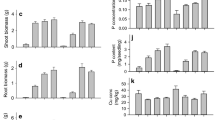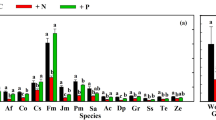Abstract
We examined the effect of two levels of soil pH (5 and 6) on the ability (effectiveness) of ectomycorrhizal fungi to increase the growth of Eucalyptus globulus Labill. at a deficient supply of P. Plants were inoculated with one of six fungal isolates [Laccaria laccata (Scop. ex Fr.) Berk. and Br. (isolates A and B), Pisolithus tinctorius (Pers.) Coker and Couch (isolates A and B), Descolea maculata Bough. and Mal. and Setchelliogaster sp. nov.] and were grown in a P-deficient sand, in pots, in a temperature-controlled glasshouse. Seedlings were harvested 89 days after planting and were assessed for dry matter production, tissue P concentrations, ectomycorrhizal colonization of roots and hyphal development in soil.
Uninoculated plants had less than 5% of their fine root length colonized by ectomycorrhizal fungi. In contrast, inoculated plants had 30% or greater of their fine root length ectomycorrhizal. Inoculation increased the uptake of P and growth of plants for all isolates and at both levels of soil pH, although growth responses to inoculation were greater at pH 6, particularly for the two L. laccata isolates. Isolates which colonized roots most extensively increased plant growth to the greatest extent. D. maculata was the most effective fungal isolate at pH 5, and both D. maculata and L. laccata A were most effective at pH 6. The effects of soil pH on plant growth were also related to some extent to the effects of soil pH on colonized root length. Growth responses to inoculation were related less well to hyphal development in soil. The L. laccata isolates formed more hyphae in soil (on a per pot, per m of fine root, and per m of colonized fine root basis) than other fungal isolates, but were not always more effective in increasing plant grown.
Similar content being viewed by others
References
Abbott L K and Robson A D 1985 The effect of soil pH on the formation of VA mycorrhizas by two species of Glomus. Aust. J. Soil Res. 23, 253–261.
Abbott L K, Robson A D and De Boer G 1984 The effect of phosphorus on the formation of hyphae in soil by the vesicular-arbuscular mycorrhizal fungus, Glomus fasciculatum. New Phytol. 97, 437–446.
Bougher N L, Grove T S and Malajczuk N 1990 Growth and phosphorus acquisition of karri (Eucalyptus diversicolor F. Muell.) seedlings inoculated with ectomycorrhizal fungi in relation to phosphorus supply. New Phytol. 114, 77–85.
Burgess T I, Malajczuk N and Grove T S 1993 The ability of 16 ectomycorrhizal fungi to increase growth and phosphorus uptake of Eucalyptus globulus Labill. and E. diversicolor F. Muell. Plant and Soil 153, 155–164.
Entry J A, Cromack K and Stafford S G 1987 The effect of pH and aluminium concentration on ectomycorrhizal formation in Abies balsamea. Can. J. For. Res. 17, 865–871.
Erland S, Soderstrom B and Andersson S 1990 Effects of liming on ectomycorrhizal fungi infecting Pinus sylvestris L. II. Growth rates in pure culture at different pH values compared to growth rates in symbiosis with the host plant. New Phytol. 115, 683–688.
Grove T S, Malajczuk N, Burgess T, Thomson B D and Hardy G 1991 Growth responses of plantation eucalypts to inoculation with selected ectomycorrhizal fungi. Proc. IUFRO Symp. ‘Intensive Forestry: the Role of Eucalypts’ Durban, South Africa, pp 86–93.
Harley J L and Smith S E 1983 Mycorrhizal Symbiosis. Academic Press, London, UK.
Hung L L and Trappe J M 1983 Growth variation between and within species of ectomycorrhizal fungi in response to pH in vitro. Mycologia 75, 234–241.
Kasuya M C M, Muchovej R M C and Muchovej J J 1990 Influence of aluminium on in vitro formation of Pinus caribeae mycorrhizae. Plant and Soil 124, 73–77.
Marx D H 1969 The influence of ectotrophic mycorrhizal fungi on the resistance of pine roots to pathogenic infections. I. Antagonism of mycorrhizal fungi to root pathogenic fungi and soil bacteria. Phytopathology 59, 153–163.
Newman E I 1966 A method for estimating the total length of root in a sample. J. Appl. Ecol. 3, 139–145.
Russell E W 1973 Soil Conditions and Plant Growth. 10th Ed. Longmans, London, UK.
Salt P D 1968 The automatic determination of phosphorus in extracts of soils made with 0.5 M sodium hydrogen carbonate and 0.01 M calcium chloride. Chem. Ind. 4, 584–586.
Thomson B D, Grove T S, Malajczuk N and Hardy G E StJ 1994 The effectiveness of ectomycorrhizal fungi in increasing the growth of Eucalyptus globulus Labill. in relation to root colonization and hyphal development in soil. New Phytol. 126, 517–524.
Author information
Authors and Affiliations
Rights and permissions
About this article
Cite this article
Thomson, B.D., Grove, T.S., Malajczuk, N. et al. The effect of soil pH on the ability of ectomycorrhizal fungi to increase the growth of Eucalyptus globulus Labill.. Plant Soil 178, 209–214 (1996). https://doi.org/10.1007/BF00011585
Received:
Accepted:
Issue Date:
DOI: https://doi.org/10.1007/BF00011585




